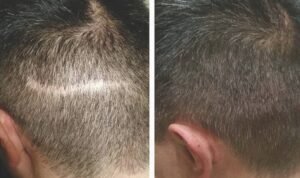Scalp Micropigmentation (SMP) | Advanced Hair Restoration & Scar Camouflage
Scalp Micropigmentation (SMP) is a cutting-edge procedure designed to replicate the appearance of shaved hair, stubble, or enhance density in areas experiencing hair loss. Over the years, SMP has gained popularity worldwide, becoming a valuable tool in hair restoration. It is often compared to procedures like Follicular Unit Excision (FUE) and Follicular Unit Transplantation (FUT) due to its effectiveness and non-invasive nature.
While SMP is relatively new, its techniques and terminology are constantly evolving, contributing to its growth and recognition within the medical and cosmetic communities. This article explores the details of SMP, its standards, terminology, and the importance of specialized training for practitioners.
The Evolution of SMP
SMP is not to be confused with Permanent Makeup (PMU) or Semi-Permanent Makeup (SPMU), though it has its roots in these procedures. As with other cosmetic treatments, the demand for SMP has surged, leading to a significant increase in practitioners and clinics offering the service globally. In the UK, the British Association of Hair Restoration Surgery (BAHRS) acknowledged its importance by introducing an affiliate membership category specifically for Scalp Micropigmentation Practitioners (SMPPs) .

SMP for Androgenetic Alopecia and Scarring
One of the most common uses of SMP is to treat androgenetic alopecia (male and female pattern hair loss). By simulating natural hair follicles, SMP provides a non-surgical solution for individuals looking to restore the appearance of fuller hair.
SMP is also used to camouflage scars resulting from hair transplant surgeries such as strip scars and FUE scars. This versatility makes it a highly sought-after solution for both aesthetic and medical concerns.
Standardizing Terminology and Procedures
The rapid growth of SMP has led to confusion about terminology and standards. Terms like semi-permanent micropigmentation, micropigmentation tattooing, and others are often used interchangeably, though distinctions exist. While the Oxford Dictionary defines “tattoo” as marking the skin with indelible pigment, SMP is often considered “semi-permanent” because the pigment can fade over time.
Key differences between tattoos and micropigmentation include:
- Mediums Used: Tattoo inks are often carbon-based, while micropigmentation pigments are metallic-oxide-based.
- Longevity: SMP pigments may fade faster due to UV exposure and other factors.
- Equipment: SMP machines and needles are designed for precision, minimizing the risk of blood-borne disease transmission.
To address these discrepancies, BAHRS introduced professional standards and guidelines to ensure clarity and safety in SMP practices.
Training and Certification for SMP Practitioners
SMP requires specialized training that goes beyond traditional tattooing or PMU techniques. In the UK, practitioners seeking BAHRS membership must complete a Level 4 qualification in SMP, as well as certifications in Blood Borne Pathogen Handling, First Aid, and Basic Life Support.
The training emphasizes:
- Understanding scalp anatomy and hair loss conditions.
- Safe handling of equipment to prevent cross-contamination.
- Mastery of pigment selection for natural-looking results.
Doctors and nurses performing SMP must meet the same standards as non-medical practitioners, highlighting the importance of specialized training over general medical or artistic tattooing expertise.
Safety in Scalp Micropigmentation
The “Safety in Micropigmentation” campaign aims to educate both professionals and clients about safe SMP practices. This includes using sterile equipment, approved pigments, and adhering to professional standards.
Health risks associated with improper SMP practices include:
- Transmission of blood-borne diseases due to incorrect needle or machine usage.
- Skin damage or allergic reactions from hazardous inks or dyes.
By adhering to strict safety guidelines, practitioners can ensure a high-quality and risk-free experience for their clients.
Organic vs. Inorganic Pigments in SMP
SMP pigments can be classified as:
- Organic Pigments: Carbon-based with smaller particle sizes, offering better UV resistance and longer-lasting results.
- Inorganic Pigments: Metallic-oxide-based, with multi-layered compounds that create varied tones but may fade faster under UV light.
Some practitioners mix these pigments to achieve desired results, but training is essential to understand how pigment selection affects longevity and client satisfaction.
Why SMP is More Than a Cosmetic Procedure
SMP is increasingly recognized as a medical procedure, particularly when addressing hair loss from conditions like male and female pattern baldness, alopecia, or scarring. The integration of medical knowledge with artistic skill makes SMP unique, requiring practitioners to balance aesthetic goals with clinical considerations.
Conclusion: SMP as the Future of Hair Restoration
Scalp Micropigmentation has evolved from its cosmetic roots into a widely accepted medical and aesthetic solution for hair loss and scarring. With standardized training, safety protocols, and advancements in techniques, SMP continues to gain recognition as a revolutionary procedure.
Whether you’re considering SMP for androgenetic alopecia, scar camouflage, or restoring density, always choose a certified practitioner who adheres to professional standards. With the right expertise, SMP can deliver life-changing results, restoring confidence and a natural appearance.